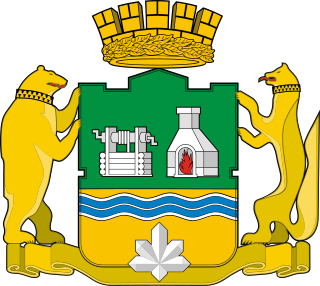
The flag of Missouri, often referred to as the Missouri flag, is the state flag of the U.S. state of Missouri. It consists of a triband of three equal horizontal stripes colored red, white, and blue, with the arms from the Great Seal of Missouri in the center. Designed by Mary Elizabeth Oliver, the red and white stripes represent valor and purity, respectively. The blue stripe represents the permanency, vigilance, and justice of the state. The three colors also highlight the French influence on the state in its early years. The Missouri flag was established on March 22, 1913, when governor Elliot Woolfolk Major signed the State flag act making it official.

The coat of arms of the state of New York was formally adopted in 1778, and appears as a component of the state's flag and seal.

The flag of Georgia is the flag of the U.S. state of Georgia. Its current iteration was adopted on February 19, 2003. The flag bears three horizontal stripes and features a blue canton containing a ring of 13 white stars that encircle the state's gold-colored coat of arms. The ring of stars that encompass the state's coat of arms represents Georgia as one of the original Thirteen Colonies.

The flag of the state of Connecticut is a white baroque shield with three grapevines, each bearing three bunches of purple grapes on a field of royal blue. The banner below the shield reads "Qui Transtulit Sustinet", Latin for "He who transplanted sustains", Connecticut's state motto. The flag dimensions are 5.5 feet (1.7 m) in length and 4.33 feet (1.32 m) in width.

The flag of Delaware consists of a buff-colored diamond on a field of colonial blue, with the coat of arms of the state of Delaware inside the diamond. Below the diamond, the date December 7, 1787, declares the day on which Delaware became the first state to ratify the United States Constitution. The colors of the flag reflect the colors of the uniform of General George Washington.

The Commonwealth of Massachusetts has been represented by official but limited-purpose flags since 1676, though until 1908 it had no state flag per se to represent its government. A variant of the white flag with blue seal was carried by each of the Massachusetts volunteer regiments during the American Civil War alongside the National Colors. An exception were the two "Irish regiments", each of which was permitted to carry an alternative green flag with a harp symbol.

The North American Vexillological Association (NAVA) is a membership organization devoted to vexillology, the study of flags. It was founded in 1967 by American vexillologist Whitney Smith, and others. Its membership of 1,100+ comprises flag scholars, enthusiasts, designers, collectors, conservators, educators, merchants, manufacturers, historians, and hobbyists from most states and provinces of the United States and Canada, and more than 30 other countries.

The seal of the Territory of Idaho was adopted in 1863 and redrawn several times before statehood in 1890. The first state Great Seal was designed in the 1890s by Emma Edwards Green, the only woman to design a U.S. state seal. That seal was used until 1957, when the seal was slightly redrawn by Paul B. Evans and the Caxton Printers, Ltd. at the request of the state government, in order to add more anthropocentric elements to the centered shield.

The city flag of Los Angeles consists of a background of three notched stripes of green, gold and red. The flag was designed by Roy E. Silent and E.S. Jones in 1931 for the Los Angeles sesquicentennial from 1781.

The flag of Vancouver was adopted by the Vancouver City Council on May 17, 1983. It was designed by Robert Watt, the director of the Vancouver Museum at the time, and later the Chief Herald of Canada. It features a white field with five wavy blue barrulets, and a green pentagon on the hoist side surmounted by a gold shield with the city badge, which consists of a mural crown with crossed axe and paddle.

The flag of Pittsburgh is a triband flag featuring vertical bands of black and gold and Pittsburgh's coat of arms in the center.

The flag of Baton Rouge contains a red field with a small shield and cursive text reading "Baton Rouge". The current flag was adopted in 1995 by the city council, replacing an older flag that had been in use since 1968.

The current flag of Billings, Montana, United States, is a "Canadian-like" triband of very dark blue and white with the city seal on the central white panel. The seal shows the Billings skyline line-drawn in blue, with a red disc representing the sun. The seal is outlined in blue with the text "Star of the Big Sky Country" in red capitals. It was designed by Fernando Méndez and adopted in June 1986.

The flag of San Antonio is the official municipal flag of San Antonio. The sketch of the flag's design, drawn by Spanish–American War veteran William W. Herring, was dated May 28, 1933. The design saw significantly more usage than the official flag, but was never officially adopted until 1976. The current flag is a slightly modified version of Herring's design, most notably removing the text formerly displayed.

The flag of Columbus is the official municipal flag of Columbus, Ohio. Its current design is a yellow, white, red vertical triband with the city seal on a blue field. Officially, the flag was adopted in 1929, although it is unknown if the flag was ever flown when it was first adopted.

The flag of El Paso is the official municipal flag of El Paso, Texas. The current design, an augmentation of El Paso's seal in the center of a dark blue field, has been in place since 1962.

The flag of Saint Paul is the official municipal flag of Saint Paul, Minnesota. Adopted via a 1932 competition, the current flag is a yellow-blue-yellow horizontal triband. A red shield depicting various aspects of St. Paul's industry and history is in the foreground and a red ribbon reading "SAINT PAUL" in yellow font below the shield.

The flag of South Bend, Indiana, was adopted by the city council during the mayorship of Pete Buttigieg on April 25, 2016. It is a field of white and yellow separated by a two blue curved lines with a white line between them and a red six-pointed star in the upper left corner.

The flag of Burlington, Vermont was adopted by the Burlington city council on November 27, 2017 during the mayorship of Miro Weinberger. It is five horizontal, zig-zag stripes of blue, white, green, white, and blue.

The coat of arms of Yekaterinburg is the official municipal coat of arms of Yekaterinburg, Russia. The current symbol was adopted on 23 May 2008 and consists of a French shield divided horizontally into two fields, with a white mine shaft and a white furnace within the top field, which is green, and a blue wavy bend within the bottom field, which is gold. A gold bear and gold sable are located to the left and right of the shield, respectively. A gold crown with a gold laurel wreath is located above the shield and a gold ribbon is located below the shield. A grey druse is located at the bottom center of the shield.






















